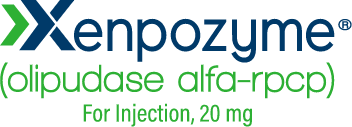ABOUT ASMD


ASMD is a progressive disease with serious, multisystemic consequences1
ASMD may result in premature death1

- Historically known as Niemann-Pick disease types A, A/B, and B, ASMD is caused by reduced activity of the enzyme acid sphingomyelinase (ASM).1
- Insufficient ASM activity causes an accumulation of sphingomyelin, which can lead to multisystemic damage, morbidity, and early mortality.1
- The signs and symptoms of ASMD include interstitial lung disease, splenomegaly, hepatomegaly, thrombocytopenia, and pediatric growth delay.1-3
Life expectancy at birth for the ASMD cohort and general population in the US in 20184

This observational, multicenter, retrospective cohort study included medical chart records retrieved from 25 medical centers in the US. The study included pediatric, adolescent, and adult patients (n=110) with ASMD non-type A (including type B, type A/B, or unspecified), surviving or deceased, with retrievable information from the US hospital medical records and the first date of evidence of ASMD, defined as either first symptom onset or a diagnosis of ASMD types B or A/B (whichever came first) between January 1, 1990, and February 28, 2021. Eligible medical chart records were abstracted to collect the evaluation criteria, including demographics, medical and developmental history, and mortality data, and characterized using descriptive statistics. Life expectancy at birth was computed as the area under the survival curve.
ASMD=acid sphingomyelinase deficiency.
Previously, no treatment had been FDA-approved for ASMD.
Patients with ASMD can experience multisystemic signs and symptoms.1,2
IMPORTANT SAFETY INFORMATION
|
WARNING: HYPERSENSITIVITY REACTIONS INCLUDING ANAPHYLAXIS Patients treated with XENPOZYME have experienced life-threatening hypersensitivity reactions, including anaphylaxis. Appropriate medical monitoring and support measures, including cardiopulmonary resuscitation equipment, should be readily available during XENPOZYME administration. If a severe hypersensitivity reaction (e.g., anaphylaxis) occurs, discontinue XENPOZYME immediately, and initiate appropriate medical treatment. In patients with severe hypersensitivity reactions, a desensitization procedure to XENPOZYME may be considered. |
WARNINGS AND PRECAUTIONS
Hypersensitivity Reactions Including Anaphylaxis
See Boxed WARNING. Prior to XENPOZYME administration, consider pretreating with antihistamines, antipyretics, and/or corticosteroids.
- If a severe hypersensitivity reaction occurs, discontinue XENPOZYME immediately and initiate appropriate medical treatment. Consider the risks and benefits of re-administering XENPOZYME following severe hypersensitivity reactions.
- If a mild or moderate hypersensitivity reaction occurs, consider temporarily holding the infusion, slowing the infusion rate, and/or reducing the XENPOZYME dose.
Infusion-Associated Reactions
Antihistamines, antipyretics, and/or corticosteroids may be given prior to XENPOZYME administration to reduce the risk of infusion-associated reactions (IARs). However, IARs may still occur in patients after receiving pretreatment.
- If severe IARs occur, discontinue XENPOZYME immediately and initiate appropriate medical treatment. Consider the risks and benefits of re-administering XENPOZYME following severe IARs.
- If a mild or moderate IAR occurs, the infusion rate may be slowed or temporarily withheld, and/or the XENPOZYME dosage may be reduced.
Acute phase reactions (APRs), acute inflammatory responses accompanied by elevations in inflammatory serum protein concentrations, have been observed. Most APRs occurred at 48 hours post infusion during the dose escalation period. APRs were managed similar to other IARs.
Elevated Transaminase Levels
XENPOZYME may be associated with elevated transaminases (ALT, AST, or both) within 24 to 48 hours after infusion. Levels generally returned to levels observed prior to the XENPOZYME infusion. To manage the risk of elevated transaminase levels, assess ALT and AST:
- within one month prior to initiation of XENPOZYME,
- within 72 hours prior to any infusion during dose escalation, which includes the first 3 mg/kg dose, or prior to the next scheduled XENPOZYME infusion upon resuming treatment following a missed dose.
Upon reaching the recommended maintenance dose, transaminase testing is recommended to be continued as part of routine clinical management of ASMD.
Risk of Fetal Malformations During Dosage Initiation or Escalation in Pregnancy
XENPOZYME dosage initiation or escalation, at any time during pregnancy, is not recommended as it may lead to elevated sphingomyelin metabolite levels that may increase the risk of fetal malformations. The decision to continue or discontinue XENPOZYME maintenance dosing in pregnancy should consider the female’s need for XENPOZYME, the potential drug-related risks to the fetus, and the potential adverse outcomes from untreated maternal ASMD disease.
Verify pregnancy status in females of reproductive potential prior to initiating XENPOZYME treatment. Advise females of reproductive potential to use effective contraception during XENPOZYME treatment and for 14 days after the last dose if XENPOZYME is discontinued.
ADVERSE REACTIONS
- Most frequently reported adverse drug reactions in adults (incidence ≥10%) were headache, cough, diarrhea, hypotension, and ocular hyperemia.
- Most frequently reported adverse drug reactions in pediatric patients (incidence ≥20%) were pyrexia, cough, diarrhea, rhinitis, abdominal pain, vomiting, headache, urticaria, nausea, rash, arthralgia, pruritus, fatigue, and pharyngitis.
INDICATION
XENPOZYME® (olipudase alfa-rpcp) is indicated for treatment of non–central nervous system manifestations of acid sphingomyelinase deficiency (ASMD) in adult and pediatric patients.
Please see full Prescribing Information for complete details, including Boxed WARNING.
References: 1. McGovern MM, Avetisyan R, Sanson B-J, Lidove O. Disease manifestations and burden of illness in patients with acid sphingomyelinase deficiency (ASMD). Orphanet J Rare Dis. 2017;12(1):41. 2. McGovern MM, Dionisi-Vici C, Giugliani R, et al. Consensus recommendation for a diagnostic guideline for acid sphingomyelinase deficiency. Genet Med. 2017;19(9):967-974. 3. Cox GF, Clarke LA, Giugliani R, et al. Burden of illness in acid sphingomyelinase deficiency: a retrospective chart review of 100 patients. JIMD Rep. 2018;41:119-129. 4. Pulikottil-Jacob R, Dehipawala S, Smith B, et al. Survival of patients with chronic acid sphingomyelinase deficiency (ASMD) in the United States: a retrospective chart review study. Mol Genet Metab Rep. 2023;38:101040.
IMPORTANT SAFETY INFORMATION
|
WARNING: HYPERSENSITIVITY REACTIONS INCLUDING ANAPHYLAXIS Patients treated with XENPOZYME have experienced life-threatening hypersensitivity reactions, including anaphylaxis. Appropriate medical monitoring and support measures, including cardiopulmonary resuscitation equipment, should be readily available during XENPOZYME administration. If a severe hypersensitivity reaction (e.g., anaphylaxis) occurs, discontinue XENPOZYME immediately, and initiate appropriate medical treatment. In patients with severe hypersensitivity reactions, a desensitization procedure to XENPOZYME may be considered. |
WARNINGS AND PRECAUTIONS
Hypersensitivity Reactions Including Anaphylaxis
See Boxed WARNING. Prior to XENPOZYME administration, consider pretreating with antihistamines, antipyretics, and/or corticosteroids.
- If a severe hypersensitivity reaction occurs, discontinue XENPOZYME immediately and initiate appropriate medical treatment. Consider the risks and benefits of re-administering XENPOZYME following severe hypersensitivity reactions.
- If a mild or moderate hypersensitivity reaction occurs, consider temporarily holding the infusion, slowing the infusion rate, and/or reducing the XENPOZYME dose.
Infusion-Associated Reactions
Antihistamines, antipyretics, and/or corticosteroids may be given prior to XENPOZYME administration to reduce the risk of infusion-associated reactions (IARs). However, IARs may still occur in patients after receiving pretreatment.
- If severe IARs occur, discontinue XENPOZYME immediately and initiate appropriate medical treatment. Consider the risks and benefits of re-administering XENPOZYME following severe IARs.
- If a mild or moderate IAR occurs, the infusion rate may be slowed or temporarily withheld, and/or the XENPOZYME dosage may be reduced.
Acute phase reactions (APRs), acute inflammatory responses accompanied by elevations in inflammatory serum protein concentrations, have been observed. Most APRs occurred at 48 hours post infusion during the dose escalation period. APRs were managed similar to other IARs.
Elevated Transaminase Levels
XENPOZYME may be associated with elevated transaminases (ALT, AST, or both) within 24 to 48 hours after infusion. Levels generally returned to levels observed prior to the XENPOZYME infusion. To manage the risk of elevated transaminase levels, assess ALT and AST:
- within one month prior to initiation of XENPOZYME,
- within 72 hours prior to any infusion during dose escalation, which includes the first 3 mg/kg dose, or prior to the next scheduled XENPOZYME infusion upon resuming treatment following a missed dose.
Upon reaching the recommended maintenance dose, transaminase testing is recommended to be continued as part of routine clinical management of ASMD.
Risk of Fetal Malformations During Dosage Initiation or Escalation in Pregnancy
XENPOZYME dosage initiation or escalation, at any time during pregnancy, is not recommended as it may lead to elevated sphingomyelin metabolite levels that may increase the risk of fetal malformations. The decision to continue or discontinue XENPOZYME maintenance dosing in pregnancy should consider the female’s need for XENPOZYME, the potential drug-related risks to the fetus, and the potential adverse outcomes from untreated maternal ASMD disease.
Verify pregnancy status in females of reproductive potential prior to initiating XENPOZYME treatment. Advise females of reproductive potential to use effective contraception during XENPOZYME treatment and for 14 days after the last dose if XENPOZYME is discontinued.
ADVERSE REACTIONS
- Most frequently reported adverse drug reactions in adults (incidence ≥10%) were headache, cough, diarrhea, hypotension, and ocular hyperemia.
- Most frequently reported adverse drug reactions in pediatric patients (incidence ≥20%) were pyrexia, cough, diarrhea, rhinitis, abdominal pain, vomiting, headache, urticaria, nausea, rash, arthralgia, pruritus, fatigue, and pharyngitis.
INDICATION
XENPOZYME® (olipudase alfa-rpcp) is indicated for treatment of non–central nervous system manifestations of acid sphingomyelinase deficiency (ASMD) in adult and pediatric patients.
Please see full Prescribing Information for complete details, including Boxed WARNING.
References: 1. McGovern MM, Avetisyan R, Sanson B-J, Lidove O. Disease manifestations and burden of illness in patients with acid sphingomyelinase deficiency (ASMD). Orphanet J Rare Dis. 2017;12(1):41. 2. McGovern MM, Dionisi-Vici C, Giugliani R, et al. Consensus recommendation for a diagnostic guideline for acid sphingomyelinase deficiency. Genet Med. 2017;19(9):967-974. 3. Cox GF, Clarke LA, Giugliani R, et al. Burden of illness in acid sphingomyelinase deficiency: a retrospective chart review of 100 patients. JIMD Rep. 2018;41:119-129. 4. Pulikottil-Jacob R, Dehipawala S, Smith B, et al. Survival of patients with chronic acid sphingomyelinase deficiency (ASMD) in the United States: a retrospective chart review study. Mol Genet Metab Rep. 2023;38:101040.

